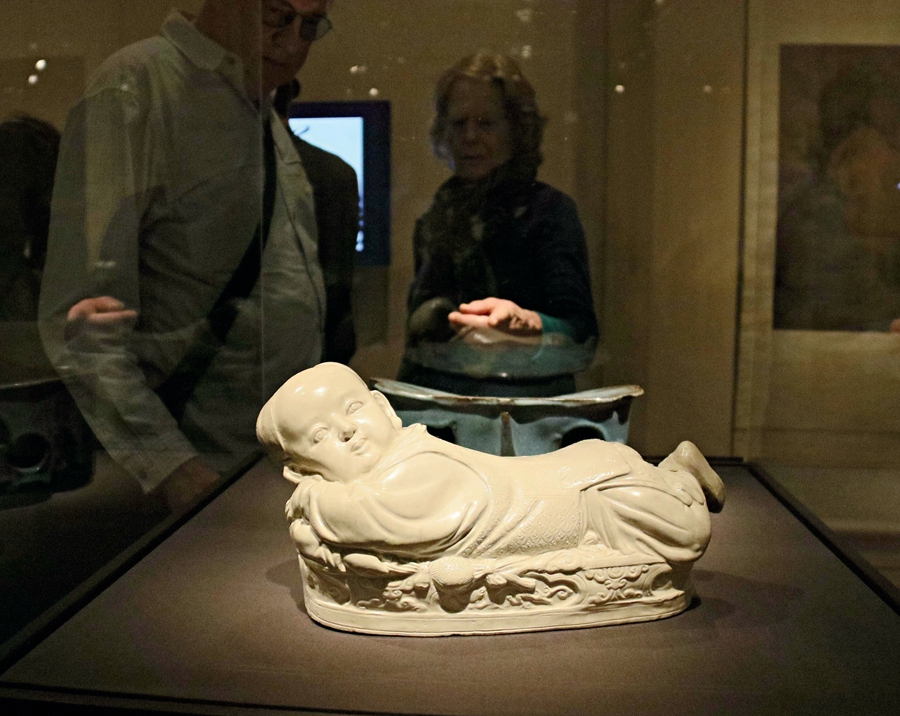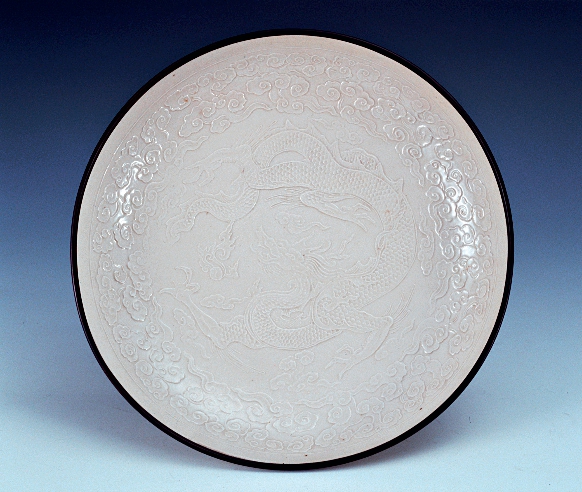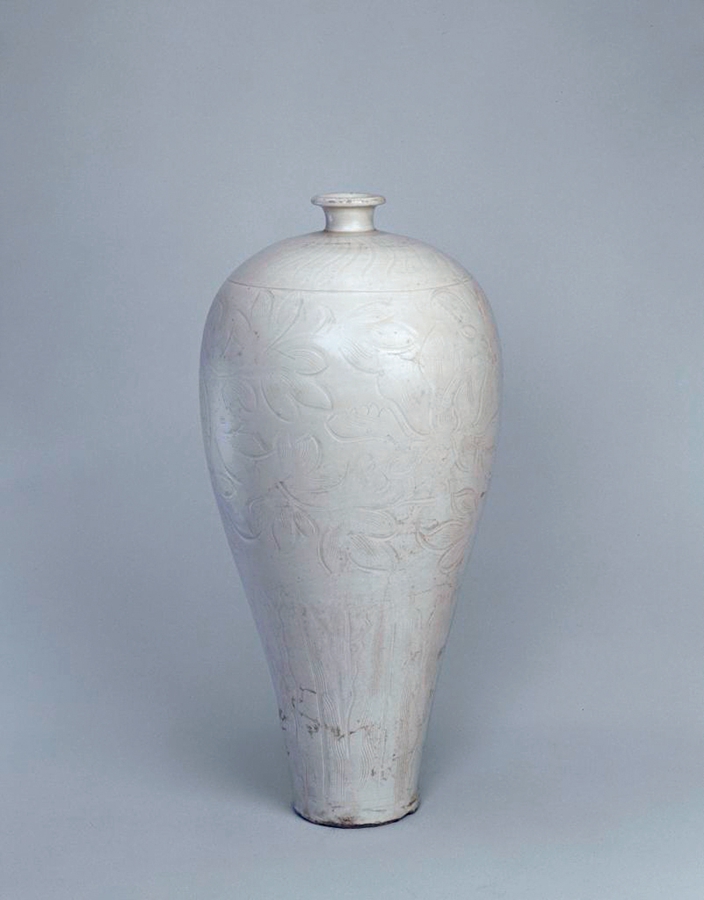By SONG XIAOYAN
By SONG XIAOYAN
DATING back to the Tang Dynasty (618-907) and peaking in the Northern Song (960-1127) and Jin (1115-1234) periods, Ding ware is famed for its thin clay body, pure white glaze, and firm texture. It is usually imprinted with decorative patterns produced by various techniques.

Boy-shaped pillow (Palace Museum in Beijing)
The ivory-colored porcelain pillow is shaped like a child lying on his stomach, with his arms folded beneath his chin and feet tipping up in the air. It was believed to be fired in a mold before being further sculptured.
Ding Ware was among the top five porcelain wares in the Song Dynasty, and was the only one of white color among them. It was named so because its production was based in Dingzhou (now Jianzi Village, Quyang County of Hebei Province). Kilns there continued operation over more than 500 years, from the Tang to Yuan (1279-1368) dynasties. Their zenith came in the Northern Song, when Ding ware was designated for use by the royal family, and therefore sold like hot cakes.
What set Ding ware apart from other porcelain was its paper-thin body, jade-white color, and chime-like sound on taps. Its glaze is smooth, sleek, and white with a smatter of warm hues, reminiscent of the fair skin of young girls or Hotan jade (a white jade from Xinjiang whose fine texture earns it the nickname “mutton fat”).
The sublime-quality glaze of Ding ware is attributed to its firing technique and the ceramic raw materials. Ding ware is baked at a temperature of over 1,300oC, compared with 1,250oC for most other ceramics. Such heat results in a fine, firm texture, and the titanium dioxide in the raw material mixture gives the glaze an ivory semblance that appeals to Chinese aesthetics.

White-glazed platter impressed with cloud and dragon pattern (Shanghai Museum)
This platter is thinly and evenly shaped, and covered in yellowish-white glaze. “Tear marks,” a hallmark of Ding ware, can be seen on its outside wall, and a dragon encircled by clouds is clearly impressed inside. The rim is covered by brass. This item is hailed as one of the best Ding wares ever made.
Firing is a critical step in the production of chinaware. To monitor and control the temperature, makers of Ding ware place clay scraps at different locations in the firing chamber, and constantly checked their changes in the firing process through a slot on the kiln door. The raw plates and bowls are stacked upside-down in the kiln, with ring-shaped clay partitions between them. This allows more items to be loaded for each firing, saves fuel, and reduces the rate of deformation, thereby significantly lowering cost and boosting productivity. The downside is that the glaze has to be scratched off the rim of the utensil beforehand to prevent sticking.

White-glazed prunus vase with carved pattern (Palace Museum in Beijing)
The vase features a short, narrow neck, round shoulders, and tapered body, which is a typical Ding prunus vase from the Song Dynasty. The white glaze is clear and mild, with a touch of yellowness. Chrysanthemum petals are carved on the shoulders, and interlocked lotus below. The engraved lines are clear, fluid, but of different depths, displaying the advanced carving techniques of Ding ware makers.
Ding ware is also distinct for its carved, incised or pressed patterns, which marks a turning point in the history of Chinese porcelain. One patterning technique is lineation with a round-tipped or bamboo lancet on the clay body of an item. There were no fixed rules to be followed in this production method, the size and shape of the engraving tool and the personal style of the potter could produce a number of elaborate, yet completely different styles of porcelain.
A stamped pattern is also representative of Ding ware. This is achieved by pressing carved blocks to the clay surface of an item before it is fully dried. This technique debuted in the mid Northern Song, and matured in the latter period of the dynasty. With influence from designs of silver and gold wares, it was artistically sophisticated, and was adopted by potteries in both northern and southern China.
The sweeping popularity of Ding ware prompted kilns in other regions to emulate its shapes, patterns, and production method, and gradually some regions could produce porcelain of equal quality. The extension of Ding ware production had a far-reaching impact on China’s porcelain industry.
Ding ware declined in the Yuan Dynasty, which some blamed on the rise of the blue and white ware made in Jingdezhen. It was brought back to life in the 1970s, when Chinese potters developed more than 200 lines of products on the basis of antique techniques. Today, Ding ware is exported to dozens of countries and regions around the world including the U.S., Japan, and Canada.
SONG XIAOYAN is a course planner of antique chinaware at the Ancient Porcelain Countyard Museum.